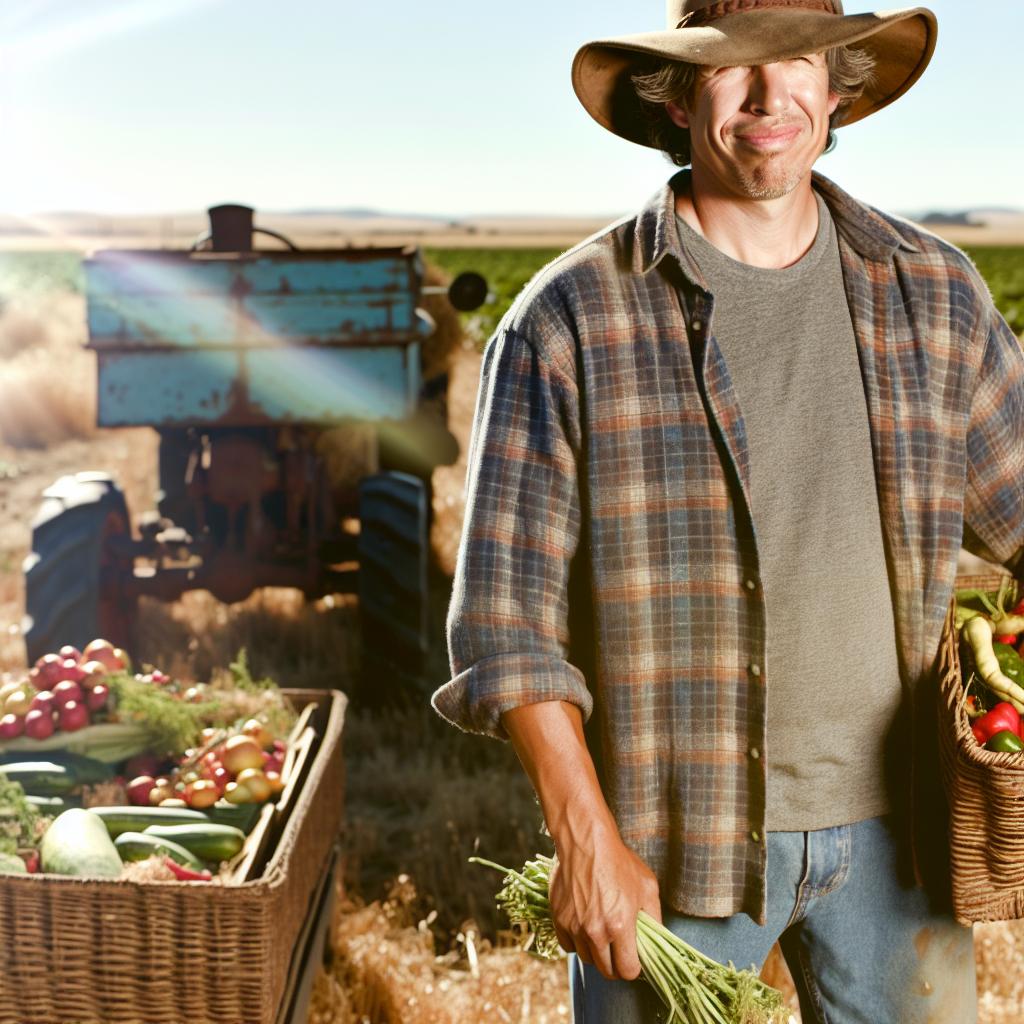Understanding the Importance of Local Food Sourcing
Strengthening Local Economies
Local food sourcing boosts local economies significantly.
This practice supports nearby farmers and businesses.
Consequently, it creates jobs within the community.
Moreover, money spent locally tends to stay within the area.
Enhancing Food Quality
Sourcing food locally often results in fresher products.
Farm-to-table transactions typically reduce transportation time.
As a result, consumers enjoy products at their peak freshness.
Higher quality food can lead to improved health outcomes.
Reducing Environmental Impact
Local sourcing diminishes the carbon footprint associated with food transportation.
Fewer miles traveled means less fuel consumption and emissions.
This practice can aid in the battle against climate change.
Additionally, local farms may utilize more sustainable practices.
Building Community Connections
Local food initiatives foster relationships between consumers and producers.
Farmers’ markets enhance community engagement and awareness.
These connections create a network of support for local agriculture.
Transform Your Agribusiness
Unlock your farm's potential with expert advice tailored to your needs. Get actionable steps that drive real results.
Get StartedAs a result, communities gain a deeper appreciation for where food comes from.
Supporting Food Security
Buying local helps ensure access to fresh food for everyone.
This approach contributes to community resilience during crises.
Investing in local farms strengthens the local food system.
Ultimately, it helps combat food deserts within urban areas.
Identifying Local Providers and Farmers
Understanding Local Sourcing
Local sourcing supports community economies and small-scale farmers.
This practice reduces transportation emissions and ensures fresher produce.
Moreover, it strengthens relationships between consumers and producers.
Researching Local Options
Start by searching online directories for local farms.
Social media platforms are also great for discovering nearby producers.
Community-supported agriculture (CSA) programs can connect you to local farms.
Engaging with Farmers’ Markets
Visit farmers’ markets to meet local producers face-to-face.
Build connections and learn about their farming practices.
Make it a habit to explore different markets each week.
Network within the Community
Join local food groups or cooperatives to find regional suppliers.
These networks often share valuable resources and contacts.
Participating in community events can lead to fruitful connections.
Evaluating Provider Practices
Assess the farming practices of local providers before purchasing.
Inquire about their techniques, sustainability efforts, and certifications.
Making informed choices enhances the impact of your sourcing decisions.
Building Long-Term Relationships
Establishing ongoing relationships with local farmers is beneficial.
Regular communication fosters trust and collaboration over time.
Consider organizing farm visits to deepen these connections.
Building Relationships with Local Food Producers
Understanding the Importance of Local Networks
Building connections with local food producers strengthens community bonds.
Showcase Your Farming Business
Publish your professional farming services profile on our blog for a one-time fee of $200 and reach a dedicated audience of farmers and agribusiness owners.
Publish Your ProfileThese relationships enhance your farm’s sustainability and resilience.
Furthermore, local sourcing reduces transportation costs and emissions.
Identifying Local Producers
Start by researching local farms and food producers in your area.
Visit farmers’ markets and agricultural fairs to meet potential partners.
Engage with local agricultural organizations for networking opportunities.
Establishing Communication
Open lines of communication with producers to foster transparency.
Regularly discuss your needs and preferences with them.
Share feedback and insights to improve product offerings.
Building Trust Over Time
Trust is essential in any relationship, especially in sourcing food locally.
Honor commitments and responsibilities to establish reliability.
Participate in community events to strengthen personal connections.
Collaborating on Sustainable Practices
Collaboration can lead to innovative sustainable practices.
Work together on projects that promote ecological farming methods.
Share resources and knowledge to benefit both parties.
Evaluating and Adapting Partnerships
Regularly assess your partnerships to ensure they remain beneficial.
Be open to making changes based on feedback from producers.
Consider seasonal adjustments to meet evolving market demands.
You Might Also Like: Effective Communication in Community Supported Agriculture
Seasonality: Knowing What to Source When
The Importance of Seasonality
Understanding seasonality is crucial for local food sourcing.
This knowledge helps in selecting the right products at the right time.
Additionally, it supports sustainable farming practices.
Identifying Seasonal Produce
Identify the produce that thrives in each season.
For instance, spring brings fresh greens and herbs.
Meanwhile, summer yields a bounty of fruits and vegetables.
- Spring: Lettuce, radishes, and strawberries.
- Summer: Tomatoes, cucumbers, and bell peppers.
- Fall: Pumpkins, squash, and apples.
- Winter: Root vegetables and hardy greens.
Building Relationships with Local Farmers
Form connections with local farms to understand their seasonal offerings.
Farmers can provide firsthand knowledge of their harvest schedules.
This collaboration leads to fresher produce for consumers.
Adapting Menus and Offerings
Restaurants should adapt menus based on seasonal availability.
This practice not only enhances flavor but also reduces costs.
Seasonal menus can attract customers seeking local dining experiences.
Benefits of Seasonal Sourcing
Seasonal sourcing reduces transportation costs and carbon footprint.
It fosters a closer connection between producers and consumers.
Moreover, seasonal ingredients are often fresher and more flavorful.
Promoting Seasonal Awareness
Educate consumers about the benefits of seasonal eating.
Share information through social media, newsletters, and events.
This awareness can drive more local food purchases.
Delve into the Subject: Effective Crop Selection Strategies for CSAs
Sustainable Practices for Local Sourcing
Establishing Local Partnerships
Begin by identifying local farms in your area.
Reach out to farmers through community events.
Build relationships with those who practice sustainable farming.
Showcase Your Farming Business
Publish your professional farming services profile on our blog for a one-time fee of $200 and reach a dedicated audience of farmers and agribusiness owners.
Publish Your ProfileFurthermore, consider collaborating with local co-ops.
These partnerships can create a reliable supply chain.
Utilizing Organic Methods
Prioritize sourcing from farms that use organic techniques.
Organic farming protects the environment and public health.
Ask potential partners about their farming practices.
For instance, inquire about pesticide use and soil health.
This knowledge helps ensure high-quality products.
Encouraging Seasonal Sourcing
Promote consuming seasonal produce grown nearby.
Seasonal sourcing reduces transportation emissions significantly.
Educate consumers about the benefits of eating local.
Moreover, seasonal produce often tastes better and fresher.
Highlight recipes that utilize seasonal ingredients.
Providing Support to Local Economies
Buying local strengthens your community’s economy.
Small farms often rely on community support to thrive.
Encourage local residents to support these farms.
Participate in farmers’ markets to offer direct support.
This approach fosters a sense of community and belonging.
Implementing Waste Reduction Strategies
Work with suppliers to minimize food waste.
Implement practices such as composting unused items.
Additionally, consider donating surplus produce to local charities.
Such actions enhance sustainability efforts.
Moreover, they positively impact those in need.
Educating Consumers on Local Benefits
Inform consumers about the advantages of local sourcing.
Explain how it supports local economies and the environment.
Use social media to share success stories and tips.
Host workshops to engage the community in these conversations.
Ultimately, education leads to more informed choices.
Monitoring and Evaluating Partnerships
Regularly assess the effectiveness of your sourcing partnerships.
Gather feedback from consumers on local products.
Adjust sourcing strategies based on this input.
This ongoing evaluation ensures long-term success.
Consequently, it fosters continuous improvement across practices.
Uncover the Details: Water Conservation Tips for Small Farm Success

Utilizing Community Supported Agriculture (CSA) Initiatives
Understanding the CSA Model
Community Supported Agriculture connects farmers directly with consumers.
Members of a CSA pay upfront for a share of seasonal produce.
This model creates a community bond between growers and eaters.
Benefits of Participating in CSAs
CSAs enhance local economies by supporting farmers directly.
They provide consumers with fresh, organic food options.
Additionally, members often receive diverse seasonal produce.
Communities benefit from reduced food transportation costs.
Showcase Your Farming Business
Publish your professional farming services profile on our blog for a one-time fee of $200 and reach a dedicated audience of farmers and agribusiness owners.
Publish Your ProfileCreating Successful CSA Programs
Effective marketing is key to attracting members.
Farmers should utilize social media and local events.
Building relationships with local businesses can enhance visibility.
Clear communication about what members can expect is essential.
Engaging the Community
Farm tours and volunteer days can foster community engagement.
These events encourage members to learn about farming practices.
Additionally, they help create a sense of ownership among consumers.
Challenges of CSA Initiatives
Weather variations can affect crop yields significantly.
Farmers should prepare for unforeseen challenges through insurance.
Flexibility in share offerings can help manage expectations.
Constant communication keeps members informed of changes.
Building Long-Term Relationships
Consistent quality and communication lead to member retention.
Farmers should solicit feedback to improve the CSA experience.
Offering additional products can enhance value for members.
Sustaining interest involves providing recipes and cooking tips.
Discover More: Local Food Sourcing Benefits for Community Farms
Marketing Strategies for Locally Sourced Products
Building Relationships with Local Producers
Establishing partnerships with local farmers strengthens your supply chain.
Regular communication fosters trust and transparency.
Collaborate on events like farmers’ markets to enhance visibility.
These relationships help you better understand your customers’ needs.
Highlighting Local Stories in Promotions
Share the stories behind your products to create emotional connections.
Use social media to showcase local producers and their farming practices.
Feature behind-the-scenes content to engage your audience.
This approach develops a sense of community around your brand.
Utilizing Community Events for Exposure
Participate in local food festivals to increase your brand’s reach.
Offer samples and engage with attendees to create buzz.
Hosting workshops about local sourcing can position you as an expert.
Furthermore, these events build loyalty and recognition in your community.
Implementing Sustainable Practices
Promote sustainability as a core value of your business.
Use eco-friendly packaging to appeal to environmentally-conscious consumers.
Highlight practices such as reducing food miles in your marketing materials.
This can attract customers seeking ethical purchasing options.
Leveraging Social Media and Digital Marketing
Utilize platforms like Instagram and Facebook to showcase local products.
Engage with followers by sharing high-quality images of fresh produce.
Run promotions specifically targeting local customers to drive sales.
Additionally, use local hashtags to increase your visibility.
Offering Loyalty Programs
Create a loyalty program that rewards customers for repeated purchases.
This encourages customers to return while celebrating local growers.
Consider offering discounts or exclusive products as incentives.
These initiatives help foster long-term customer relationships.
Showcase Your Farming Business
Publish your professional farming services profile on our blog for a one-time fee of $200 and reach a dedicated audience of farmers and agribusiness owners.
Publish Your ProfileLeveraging Technology for Efficient Local Sourcing
Utilizing Digital Platforms
Digital platforms streamline local sourcing for farms.
They connect farmers directly with local consumers.
Using e-commerce sites enhances visibility for farm products.
Farmers can sell surplus produce without intermediaries.
Furthermore, mobile apps can help manage orders effectively.
Implementing Supply Chain Management Tools
Supply chain management tools increase efficiency for farms.
These tools help track inventory levels in real time.
Farmers can reduce waste through better inventory management.
Automated systems predict demand based on historical data.
This way, farmers can optimize their production schedules.
Adopting Precision Agriculture Technologies
Precision agriculture technologies enhance local food sourcing.
These technologies improve crop yield and quality.
Drones help monitor crop health from above.
Additionally, soil sensors provide insights into nutrient needs.
Farmers gain data-driven decisions for more sustainable practices.
Engaging with Social Media
Social media provides a platform for farmers to engage customers.
Farmers can share their stories and farm practices online.
This approach builds trust with local consumers.
Furthermore, social media events can promote special offers.
Engagement through these platforms boosts farm visibility.
Collaborating with Local Businesses
Partnerships with local businesses strengthen local sourcing.
Farmers can supply fresh produce to restaurants and markets.
Collaborations increase the reach of local products.
Additionally, joint marketing campaigns attract more customers.
This strategy creates a robust network for local food sourcing.




